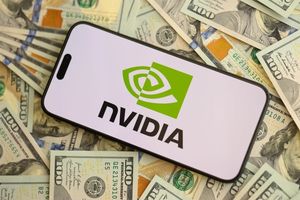
Nvidia Corporation (NASDAQ: NVDA), the undisputed titan of artificial intelligence (AI) chip manufacturing, has emerged as a singular force dictating the ebb and flow of Wall Street sentiment and the broader trajectory of the AI market. From late 2024 through November 2025, the company's meteoric financial performance and relentless innovation have not only propelled its own valuation into unprecedented territory but have also become a critical barometer for the health and direction of the entire tech sector. Its stock movements, whether soaring to new heights or experiencing significant pullbacks, send ripples across global financial markets, underscoring Nvidia's pivotal role in the ongoing AI revolution.
The immediate significance of Nvidia's dominance cannot be overstated. As the foundational infrastructure provider for AI, its GPUs power everything from large language models to advanced scientific research. Consequently, the company's earnings reports, product announcements, and strategic partnerships are scrutinized by investors and industry analysts alike, often setting the tone for market activity. The sheer scale of Nvidia's market capitalization, which briefly surpassed $5 trillion in 2025, means that its performance has a direct and substantial impact on major indices like the S&P 500 and Nasdaq Composite, making it a bellwether for the entire technology-driven economy.
The Unseen Engines: Nvidia's Technical Prowess and Market Dominance
Nvidia's profound influence stems directly from its unparalleled technical leadership in the design and production of Graphics Processing Units (GPUs) specifically optimized for AI workloads. Throughout 2024 and 2025, the demand for these specialized chips has been insatiable, driving Nvidia's data center revenue to record highs. The company's financial results consistently exceeded expectations, with revenue nearly doubling year-over-year in Fiscal Q3 2025 to $35.08 billion and reaching $39.3 billion in Fiscal Q4 2025. By Fiscal Q2 2026 (reported August 2025), revenue hit $46.7 billion, demonstrating sustained, explosive growth. This remarkable performance is underpinned by Nvidia's continuous innovation cycle and its strategic ecosystem.
At the heart of Nvidia's technical advantage is its aggressive product roadmap. The Blackwell chip architecture, introduced in March 2024, has been central to the current competitive landscape, with its Ultra version slated for release in 2025. Looking further ahead, Nvidia has announced the Rubin platform for 2026, the Rubin Ultra for 2027, and the Feynman architecture for 2028, ensuring an annual upgrade cycle designed to maintain its technological edge. These chips offer unparalleled processing power, memory bandwidth, and interconnectivity crucial for training and deploying increasingly complex AI models. This differs significantly from previous approaches that relied on less specialized hardware, making Nvidia's GPUs the de facto standard for high-performance AI computation.
Initial reactions from the AI research community and industry experts have been overwhelmingly positive, albeit with some concerns about market concentration. Researchers laud the increased capabilities that allow for the development of larger and more sophisticated models, pushing the boundaries of what AI can achieve. Industry leaders, meanwhile, acknowledge Nvidia's indispensable role, often citing the need for access to its latest hardware to remain competitive. The entire 2025 production of Blackwell chips was reportedly sold out by November 2024, with hyperscale customers significantly increasing their acquisition of these units, purchasing 3.6 million units in 2025 compared to 1.3 million Hopper GPUs in 2024, highlighting the unprecedented demand and Nvidia's commanding market share, estimated at over 80% for AI GPUs.
Shifting Sands: Implications for AI Companies and Tech Giants
Nvidia's towering presence has profound implications for AI companies, tech giants, and nascent startups alike, reshaping the competitive landscape and strategic priorities across the industry. Companies heavily invested in AI development, particularly those building large language models, autonomous systems, or advanced data analytics platforms, stand to directly benefit from Nvidia's continuous hardware advancements. Their ability to innovate and scale is often directly tied to access to Nvidia's latest and most powerful GPUs. This creates a symbiotic relationship where Nvidia's success fuels the AI industry, and in turn, the growth of AI applications drives demand for Nvidia's products.
For major AI labs and tech companies such as Microsoft (NASDAQ: MSFT), Amazon (NASDAQ: AMZN), Google (NASDAQ: GOOGL), and Oracle (NYSE: ORCL), strategic partnerships with Nvidia are paramount. These cloud service providers integrate Nvidia's GPUs into their infrastructure, offering them to customers as a service. This not only enhances their cloud offerings but also solidifies Nvidia's ecosystem, making it challenging for competitors to gain significant traction. The reliance on Nvidia's hardware means that any disruption in its supply chain or a significant shift in its pricing strategy could have far-reaching competitive implications for these tech giants, potentially impacting their ability to deliver cutting-edge AI services.
The market positioning created by Nvidia's dominance can lead to potential disruption for existing products or services that rely on less efficient or older hardware. Startups, while benefiting from the powerful tools Nvidia provides, also face the challenge of securing adequate access to the latest chips, which can be costly and in high demand. This dynamic can create a barrier to entry for smaller players, consolidating power among those with the resources and strategic partnerships to acquire Nvidia's high-end hardware. Nvidia's strategic advantage lies not just in its chips but in its comprehensive software ecosystem (CUDA), which further locks in developers and fosters a robust community around its platforms.
A New Era: Wider Significance and the AI Landscape
Nvidia's ascent fits squarely into the broader AI landscape as a defining characteristic of the current era of accelerated computing and deep learning. Its performance has become a bellwether for the "AI boom," reflecting the massive investments being poured into AI research and deployment across every sector. This growth is not merely a cyclical trend but represents a fundamental shift in how computing resources are utilized for complex, data-intensive tasks. The impacts are far-reaching, from accelerating drug discovery and scientific simulations to revolutionizing industries like automotive, finance, and entertainment.
However, this unprecedented growth also brings potential concerns, most notably the concentration of power and wealth within a single company. Critics have drawn comparisons to the dot-com bubble of 2000, citing the high valuations of AI stocks and the potential for "valuation fatigue." While Nvidia's underlying technology and robust demand differentiate it from many speculative ventures of the past, the sheer scale of its market capitalization and its influence on broader market movements introduce a degree of systemic risk. A significant downturn in Nvidia's stock, such as the over 16% drop by November 7, 2025, which wiped out approximately $800 billion in market value, can trigger widespread concerns and volatility across the market, as evidenced by SoftBank's decision to sell its entire stake on November 11, 2025.
Despite these concerns, most analysts maintain a bullish long-term outlook, viewing Nvidia as a fundamental driver of the AI revolution rather than just a beneficiary. The current AI milestone, driven by advancements in GPU technology, stands apart from previous tech breakthroughs due to its pervasive applicability across almost every industry and its potential to fundamentally alter human-computer interaction and problem-solving capabilities. Nvidia's role is akin to that of Intel (NASDAQ: INTC) in the PC era or Cisco (NASDAQ: CSCO) during the internet build-out, providing the essential infrastructure upon which a new technological paradigm is being built.
The Road Ahead: Future Developments and Challenges
Looking ahead, the trajectory of Nvidia and the broader AI market promises continued rapid evolution. Experts predict that Nvidia will continue to push the boundaries of chip design, with its aggressive roadmap for Rubin, Rubin Ultra, and Feynman architectures ensuring sustained performance improvements. Expected near-term developments include further integration of its hardware with advanced software stacks, making AI development more accessible and efficient. Long-term, Nvidia is poised to capitalize on the expansion of AI into edge computing, robotics, and immersive virtual environments, expanding its market beyond traditional data centers.
Potential applications and use cases on the horizon are vast and transformative. We can anticipate more sophisticated AI models capable of truly understanding and generating human-like content, accelerating scientific breakthroughs in materials science and biology, and enabling fully autonomous systems that operate seamlessly in complex real-world environments. Nvidia's investment in Omniverse, its platform for building and operating metaverse applications, also points to future opportunities in digital twins and virtual collaboration.
However, significant challenges need to be addressed. The escalating power consumption of AI data centers, the ethical implications of increasingly powerful AI, and the need for robust regulatory frameworks are paramount. Competition, while currently limited, is also a long-term factor, with companies like AMD (NASDAQ: AMD) and Intel investing heavily in their own AI accelerators, alongside the rise of custom AI chips from tech giants. Experts predict that while Nvidia will likely maintain its leadership position for the foreseeable future, the market will become more diversified, with specialized hardware catering to specific AI workloads. The challenge for Nvidia will be to maintain its innovation pace and ecosystem advantage in an increasingly competitive landscape.
A Defining Moment: Comprehensive Wrap-up
Nvidia's journey from a graphics card manufacturer to the linchpin of the AI economy represents one of the most significant narratives in modern technology. The key takeaways from its performance in late 2024 and 2025 are clear: relentless innovation in hardware and software, strategic ecosystem development, and unparalleled demand for its AI-enabling technology have cemented its position as a market leader. This development's significance in AI history cannot be overstated; Nvidia is not just a participant but a primary architect of the current AI revolution, providing the essential computational backbone that powers its rapid advancements.
The long-term impact of Nvidia's dominance will likely be felt for decades, as AI continues to permeate every facet of society and industry. Its technology is enabling a paradigm shift, unlocking capabilities that were once confined to science fiction. While concerns about market concentration and potential "AI bubbles" are valid, Nvidia's fundamental contributions to the field are undeniable.
In the coming weeks and months, investors and industry observers will be watching for several key indicators: Nvidia's upcoming earnings reports and guidance, announcements regarding its next-generation chip architectures, and any shifts in its strategic partnerships or competitive landscape. The continued pace of AI adoption and the broader economic environment will also play crucial roles in shaping Nvidia's trajectory and, by extension, the fortunes of Wall Street and the AI sector. As long as the world remains hungry for intelligent machines, Nvidia's influence will continue to be a dominant force.
This content is intended for informational purposes only and represents analysis of current AI developments.
TokenRing AI delivers enterprise-grade solutions for multi-agent AI workflow orchestration, AI-powered development tools, and seamless remote collaboration platforms.
For more information, visit https://www.tokenring.ai/.





